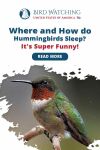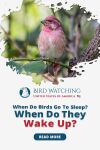
What’s This Post About?
Hummingbirds are fascinating tiny creatures who are bubbling with energy. They don’t seem to slow down much. But just like we need a good amount of rest to regain our energy after a long day of work, similarly hummingbirds need sufficient hours of sleep as well.
Hummingbirds burn heaps of energy moving around and fetching sweet nectar throughout the day. And then spend even more energy trying to stay warm when asleep. A hummingbird only rests when darkness befalls. They fly to their haven to keep warm and to restore their spent energy.
Hummingbirds mostly sleep on tree branches or nests that they consider safe. Usually hanging upside down, they slow down their system and appear to breathe steadily. This state is called ‘torpor.’ When you observe a hummingbird in such a state, make sure you do not disturb them.
Where do Hummingbirds Sleep?
Hummingbirds consume lots of energy the entire day. They are continuously in flight, fluttering even while they eat, so at the end of the day, they need a good restful night’s sleep. To sleep, they find places in between trees or on extended branches.
However, the worry is that they are so tiny that even a slightly cooler weather can lower their body temperature leading to their death while they are asleep. They often look for a tree branch or twig that is safe and sheltered from the wind.
Did You Know
When it’s cold, their bodies function in a way that they can enter a deep hibernation sleep-like state also known as torpor. It usually happens on chilly nights, but at times when they have overspent their energy, they can go into a torpid state in the daytime as well.
What is a Torpor State?

When it’s cold at night and all we feel are the chills, we can always grab warm clothes, or warm blankets. But that is not the case with hummingbirds. Rather, they enter into a voluntarily developed state, called ‘torpor’. In this state, they consume less energy at nighttime while they sleep.
-
First, during a cold night, their body temperature can drop so low that they can even die if they go into a hypothermic state. So, to keep warm, they end up using a lot of energy. In a torpor state, it is easier for them to hold on to their energy.
-
While awake their heart rate is up to 1200 bpm. While in torpor state, it slows down till 50 bpm, making it seem like they are not breathing altogether, literally!
-
Their metabolism also drops to 1/15 to its normal value and it helps them to save 60% of their energy.
Why Hummingbirds Need Good Rest?
Hummingbirds are always hustling to assist their staggering speedy wings. Throughout the day, they feed constantly on nectar and insects, so that they can build energy to compensate for the lost energy. They need rest so that they can carry on with their tasks in the future.
Fun Fact
They eat more than three times their body weight to survive throughout the day.
Do Hummingbirds Sleep During the Day?
The question is, do they? Or do they not?
You might catch a hummingbird sleeping on a warm summer afternoon after eating a bellyful. A bird’s got to nap too. They can get a handy amount of rest during the day. However, it won’t be a deep slumber state, unlike nighttime.
In the daytime, most hummingbirds seep in and out of torpor to make it to the next morning. But, now and then, you can catch a hummingbird dozing off in this state during the day. They take a risk for about half an hour or more against slim odds.
So, when the night falls, these little birds know that it’s time for bed.
A Closer Insight into How Hummingbirds Sleep
These small creatures are a package full of surprises. They don’t always follow the same sleep pattern. There are a few exceptions.
Sometimes, hummingbirds will find a place with lots of unnatural light even though it is nighttime, like a garden or a porch area. Then if the birds deem it to be fit, they will look for some night snack. It is like a night out for birds when they are out exploring.
You can always hang some nests of your own in your backyard. In case, there is a hummingbird that wishes to rest or consider it as a shelter, you help attract them. Explore the COYMOS hummingbird nest for this.
COYMOS Hummingbird Nesting
This globe hummingbird nester is hand-woven from natural rattan, which is safe and durable. This nester also does a good job of holding the nesting material through rain and wind storms.
Where Do Hummingbirds Sleep During Migration?
During migration, hummingbirds travel hundreds to thousands of miles. They consume boatloads of energy because they usually fly throughout the day and rest at nighttime. If they are crossing or passing over an ocean, where they do not have a place to rest, they can still manage to travel for hours without a pause.
Wonder how they endure these long flying hours without taking a rest? They eat in excess. They overeat to prepare for a journey across the lands and oceans.
Did You Know?
For instance, Ruby-Throated Hummingbirds fly for more than 20 hours without taking a rest to the Gulf of Mexico from Texas.
Keep Reading!
Hummingbirds sleep on trees and branches. Like us humans, they can’t sleep or rest whenever it suits them. They have a pattern and they stick to it.
It is not very common to observe hummingbirds while they’re asleep. Like other animals, it is pretty uneventful. They just need a comfy twig or a tree branch and it is their equivalent of a human’s king-sized bed. As long as it is safe and dark, they won’t be too picky about their resting nest.
I hope this post was able to give some great insight about where and how do hummingbirds sleep. If you want to learn more about hummingbirds, you can always read our post on the best place to hang hummingbird feeders to attract these beautiful birds to your backyard.
Sun or Shade? Somewhere In Between? Hang Your Hummingbird Feeder for Best Results!
Where should hummingbird feeders be placed, in sun or shade? It is better to place them in the shade to protect them from the environment.

By David A. Swanson
Bird Watching USA
My name is David and I'm the the founder of Bird Watching USA! I started Bird Watching with My father-in-law many years ago, and I've become an addict to watching these beautiful creatures. I've learnt so much over about bird watching over the years that I want to share with the world everything I know about them!

David A. Swanson
Bird Watching USA
My name is David and I'm the the founder of Bird Watching USA! I started Bird Watching with My father-in-law many years ago, and I've become an addict to watching these beautiful creatures. I've learnt so much over about bird watching over the years that I want to share with the world everything I know about them!




![Pigeons Sitting Down - Why Do They Do It? [12 Funny Photos] Thumbnail](/assets/resized/img/posts/pigeons-sitting-down-100x150.jpg)


![Pigeons Sitting Down - Why Do They Do It? [12 Funny Photos] Thumbnail](/assets/resized/img/posts/pigeons-sitting-down_thumbnail-100x56.jpg)


